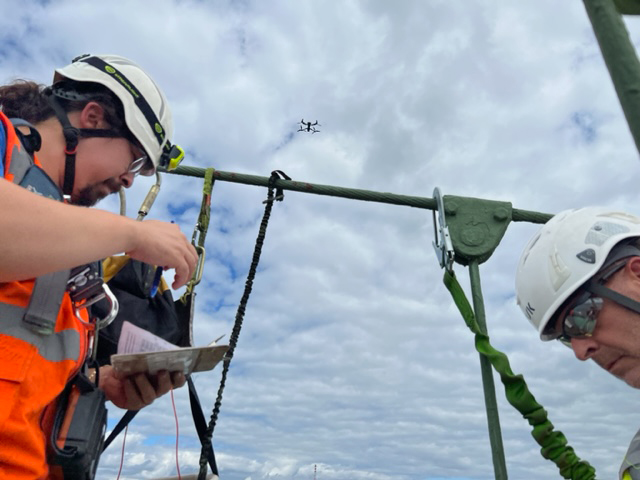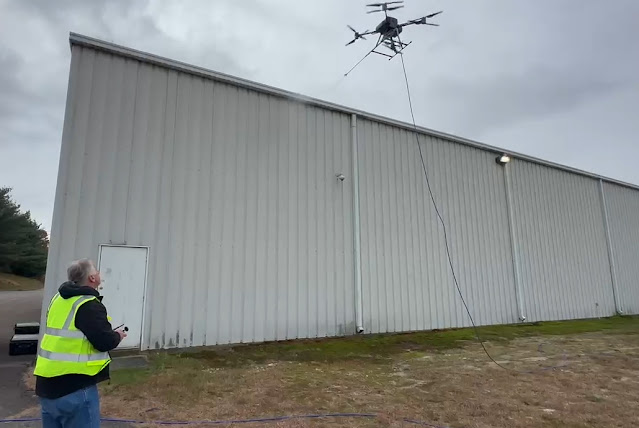By April Leigh & Tina Werner
Graffiti-battling drones. It almost sounds like something you'd see in a sci-fi movie. They could be coming soon to a bridge or overpass near you.
Our Tacoma area maintenance crew, led by Mike Gauger, is testing drone technology that can remove graffiti from hard-to-reach places. The team is learning how these drones operate, how they apply paint and if they can cover graffiti.
The drone, built from an Aquiline Endure model, uses a spray nozzle and is linked to a paint supply on the ground.
 |
| A prototype drone test sprays paint to cover up graffiti in Tacoma earlier this spring |
An operator on the ground can position the drone anywhere the tethered hose can reach. This could - make quick work of painting over graffiti on tall retaining walls, bridges and overpasses.
The problem
Graffiti damages state property. It also is a challenge for our maintenance crews to address. More importantly, it puts the people who participate in the activity and our own crews at risk. Under Washington state law, graffiti is illegal.
 |
| Tall bridges and overpasses are targets for graffiti and difficult for crews to clean up |
Graffiti removal is part of our maintenance program. The same program patches potholes, repairs guardrail and culverts, and handles snow and ice response. In 2023, our maintenance crews spent over $815,000 on graffiti removal statewide (including staff time and equipment). That's nearly 10,300 hours of labor spent covering 700,000 square feet of graffiti along our highways. But that's still not enough to remove all the graffiti that appears along our highways.
Our crews report seeing new graffiti appear sometimes days or even hours after an area is cleaned.
An inventive idea
Mike remembers the exact day two years ago he got the idea for a graffiti-fighting drone.
For the second time in one week, Mike had to send a maintenance team to paint over graffiti on the Capital Boulevard Bridge in Olympia. Our crews prioritize the removal of graffiti that contains offensive or obscene images or profanity because it is distracting to drivers.
Mike knew the graffiti had to be removed, but it was frustrating to pull a bridge maintenance crew from another task. Plus, there's an equipment challenge. Specialized trucks, called UBITs, are needed for hard-to-reach graffiti. These trucks are in high demand, and we have six of them to cover the state. They are usually reserved for higher-priority bridge maintenance and inspection work.
After scheduling the work, he thought to himself, there must be a better way to get paint up there.
 |
| Crews at the State Route 16 Tacoma Narrows Bridge using drones equipped with high resolution cameras to complete inspections last fall |
Then, he had a lightbulb moment. He was working with the Tacoma Narrows Bridge team using drones for bridge inspections. The drones, equipped with high resolution cameras, were decreasing the number of times crews had to physically inspect underneath the girders. That meant improved employee safety, less time on the inspection and overall cost savings.
If drones could be used for inspections, why couldn't they be used to spray paint?
Bringing it to life
Mike brought the idea to our maintenance director, who suggested a grant for a pilot program to research the idea.
Mike researched the use of drones with several manufacturers who produced similar products, and learned that there were no drones being designed to do things like this. He reached out to some drone manufacturers and found one that was willing to collaborate on the design of a prototype system.
 |
| Mike flying a test drone during research and design last fall |
The team worked together on the design for months. Their first attempt malfunctioned in early testing, which gave them the information they needed to make adjustments. A final working prototype was delivered in spring of 2024.
We are the first transportation agency to pilot the use of drones to combat graffiti.
House Bill 1989
In 2024, the Washinton legislature passed House Bill 1989. The bill provides us $1 million to research traffic camera technology for monitoring graffiti removal. A small portion of the funding will cover crew labor and paint for prototype drone testing for the rest of the year.
We are in the preliminary phase of identifying and researching implementation of the bill.
In December 2024, we will submit a report to the Legislature about the facts and findings of the pilot program for further evaluation. Again, this is only a pilot program, so it will be a while before we know if this is technology that we will implement in the long-term.
Field testing
To the best of our knowledge, the prototype graffiti drone is the only one of its kind. We've used drones before in other capacities like bridge inspections and disaster response (flooding, landslides, etc.), but use for graffiti removal is new.
Our highway maintenance employees with Part 107 drone licenses are being trained to operate the drone. Mike and his crew will spend the rest of the year field testing the prototype drone in the Tacoma and Olympia area.
Legally, drones cannot be flown over active lanes of traffic, so the areas we are treating will be in closed work zones or managed with rolling slowdown closures while the drones are in use.
As they field test the drone, the team expects to make further improvements to the system.
This pilot program won't end highway graffiti – it's a constant struggle for our crews and law enforcement to address – but it's another tool in our toolbox. We are excited to continue exploring new technologies to keep our crews safer and make them more efficient.
No comments:
WSDOT comment policy
Post a Comment